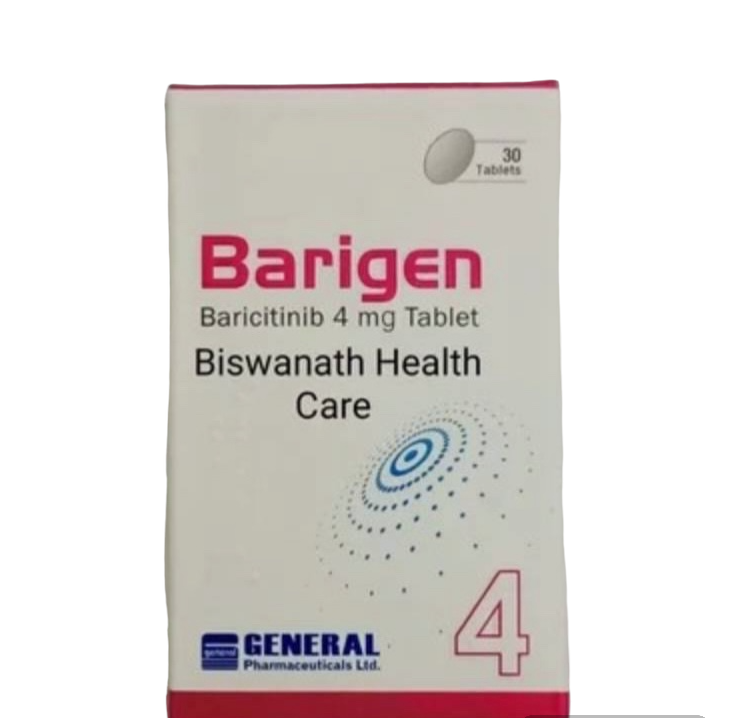Baricitinib (Olumiant) 4 mg 30 tab
€96
For the treatment of active rheumatoid arthritis
In stock
Baricitinib (Olumiant) 4 mg 30 tab
Product Details
Baricitinib (Olumiant) 4 mg 30 tab
Active substance:
Baricitinib
Dosage form, dosage
Film-coated tablets, 2 mg and 4 mg
Pharmacotherapeutic group:
Antineoplastic and immunomodulatory drugs. Immunosuppressants. Immunosuppressants are different. Immunosuppressants are selective. Baricitinib.
ATX code L04AA37
Indications for use
- the drug Baricitinib is indicated for the treatment of active rheumatoid arthritis of moderate to severe severity in adult patients with intolerance or lack of an adequate response to treatment with one or more basic antirheumatic drugs. it can be used in monotherapy mode or in combination with methotrexate
- the drug Baricitinib is indicated for the treatment of moderate to severe atopic dermatitis in adult patients who are candidates for systemic therapy.
- the drug Baricitinib is indicated for the treatment of severe focal alopecia in adult patients.
The list of information required before the start of application
Contraindications
- hypersensitivity to the active substance or to any of the excipients
- pregnancy.
Necessary precautions for use
Infections
Before prescribing therapy to patients with an active form of an infectious disease, or with chronic or recurrent infections, it is necessary to carefully assess the ratio of benefits and risks associated with the use of the drug Baricitinib. With the development of infection, it is necessary to closely monitor the patient's condition and temporarily discontinue therapy with Baricitinib if the patient does not respond to standard therapy. Therapy should not be resumed until the infection resolves.
Tuberculosis
Before starting therapy with Baricitinib, it is necessary to screen the patient for tuberculosis (TB). Baricitinib should not be used in patients with active tuberculosis. It is necessary to consider the possibility of anti-tuberculosis therapy before starting drug therapy in patients with untreated latent TB.
Hematological disorders
Therapy should not be started or it is necessary to temporarily suspend the drug in patients who, during standard follow-up, showed a decrease in the following indicators: the absolute number of neutrophils (ANC) <1x109 cells / l, the absolute number of lymphocytes (ALC) <0.5 x109 cells / l and hemoglobin levels <8 g / dl.
The risk of developing lymphocytosis is increased in elderly patients with rheumatoid arthritis. Data on rare cases of lymphoproliferative disorders have been reported.
Reactivation of a viral infection
If a patient develops shingles, therapy with Olumiant™ should be temporarily discontinued until this episode is resolved.
Before starting therapy with Olumiant™, screening for the presence of viral hepatitis should be carried out in accordance with clinical recommendations.
If HBV DNA is detected, consult with a hepatologist about the need to discontinue treatment.
Vaccination
There is no data on the reaction to vaccination with live vaccines in patients receiving baricitinib. It is not recommended to use live attenuated vaccines during or immediately before drug therapy. Before starting therapy, patients are advised to receive all vaccinations in accordance with current immunization guidelines.
Recommendations for use
Treatment should be prescribed by a doctor who has experience in the diagnosis and treatment of conditions in which Baricitinib is indicated.
Dosage regimen
Rheumatoid arthritis
The recommended dose of Baricitinib is 4 mg once a day. The drug at a dose of 2 mg per day is suitable for patients aged 75 years and older, as well as patients with a history of chronic or recurrent infection. The administration of the drug at a dose of 2 mg once a day can be considered for patients who have managed to achieve stable disease control while taking the drug at a dose of 4 mg once a day and who can be recommended to reduce the dose.
Atopic dermatitis
The recommended dose of Baricitinib is 4 mg once a day. The drug at a dose of 2 mg per day is suitable for patients aged 75 years and older, as well as patients with a history of chronic or recurrent infection. The administration of the drug at a dose of 2 mg once a day can be considered for patients who have managed to achieve stable disease control while taking the drug at a dose of 4 mg once a day and who can be recommended to reduce the dose.
Baricitinib can be used with or without corticosteroids for topical use. The effectiveness of the drug Baricitinib can be increased when used with corticosteroids for topical use. Topical calcineurin inhibitors can also be used, but only for sensitive areas such as the face, neck, diaper rash and genitals.
The need to discontinue therapy in patients who have no therapeutic effect after 8 weeks of treatment should be considered.
Focal alopecia
The recommended dose of Baricitinib is 4 mg once a day. A dose of 2 mg once a day may be offered to patients over 75 years of age, as well as patients with a history of chronic or recurrent infections. A dose of 2 mg once a day may be considered for patients who have achieved stable control over the activity of the disease when taking 4 mg once a day, and who are shown to reduce the dose.
After receiving a stable response to treatment, it is recommended to continue treatment for at least several months in order to avoid relapse. The benefit/risk ratio of treatment should be assessed at regular intervals individually for each patient.
The need to discontinue therapy in patients who have no improvement after 36 weeks of treatment should be considered.
Method and route of administration
For oral use.
Frequency of use with indication of the time of admission
The drug Baricitinib is taken once a day at any time, regardless of food intake.
Measures to be taken in case of overdose
No specific toxic effects were detected. Data from a pharmacokinetic study of the use of a single dose of 40 mg in healthy volunteers indicate that more than 90% of the administered dose is excreted within 24 hours. In case of overdose, it is recommended to monitor the patient's condition to identify signs and symptoms of adverse reactions. If adverse reactions develop in patients, appropriate treatment should be carried out.

